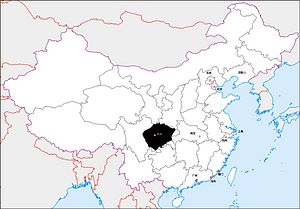This article series explores 12 distinct “regions” within China: six “core” regions long dominated by the majority Han ethnic group and six “periphery” regions home to many of China’s ethnic minorities. The series overview is available here. To view the full series, click here.
Ringed by mountains, the fertile Sichuan basin was traditionally known as “the land of heaven’s bounty” (天府之国). From the basin’s western rim, the land rises sharply into mountains and high grasslands inhabited by Tibetans and related peoples, an area containing some of China’s most brilliant natural jewels.
In the bronze age, the Sichuan basin evolved a culture distinct from that of the North China plain, and the region’s fecundity and defensibility made it a recurring base for independent regimes throughout Chinese history. Denuded in the 1600s by the ravages of a deranged warlord, Sichuan was re-peopled within a few decades to rise again as one of China’s most populous provinces.
Known worldwide for its spicy-peppery cuisine and within China for its laidback lifestyle, Sichuan remains one of China’s leading agricultural regions, while retaining large tracts of forest and the majority of the nation’s wild pandas. The provincial capital of Chengdu is a rising center of the electronics, automotive, and alternative energy industries. In 2008 the great Sichuan earthquake, which shook buildings 1,700 km away in Shanghai, took 69,000 lives and led to a social media-fueled citizen response alongside an extended military rescue operation.
Sichuan benefited from the “third front” policy of the 1960s, which moved industrial plant to China’s interior away from potential Soviet and American attack, and today the province looms large in the nation’s aerospace and defense sectors. The Chengdu Aerospace Corporation developed the People’s Liberation Army’s workhorse J-10 fighter (China’s first indigenously designed military aircraft), and is developing the J-20 stealth fighter. The Xichang space launch center is located in Sichuan’s mountainous south, an area scattered with the wrecks of American planes that flew the Hump route to bring supplies to Free China during World War II. Chengdu is headquarters to the PLA Western Theater Command, which has responsibility for defense of almost half the nation’s territory, including the disputed frontier with India.
In 1997 the city of Chongqing (the Republic of China’s temporary capital during World War II), nestled in the mountains on the basin’s eastern rim at the start of the fabled Yangtze Gorges, was detached from Sichuan as China’s fourth national-level municipality. As the transhipment hub that kicked off China’s direct rail freight links to Europe, Chongqing is emerging as a key logistics center, with a helping hand from Singapore. The city was the powerbase of the princeling politician Bo Xilai, who prior to his political demise in 2012 pioneered the “Chongqing model” of governance, characterized by massive public works, egalitarian social policies, and promotion of Mao-era “red culture.”
Next up: The central-south region.
John Lee is a former visiting fellow of the Mercator Institute for China Studies. He tweets at @J_B_C16.

































